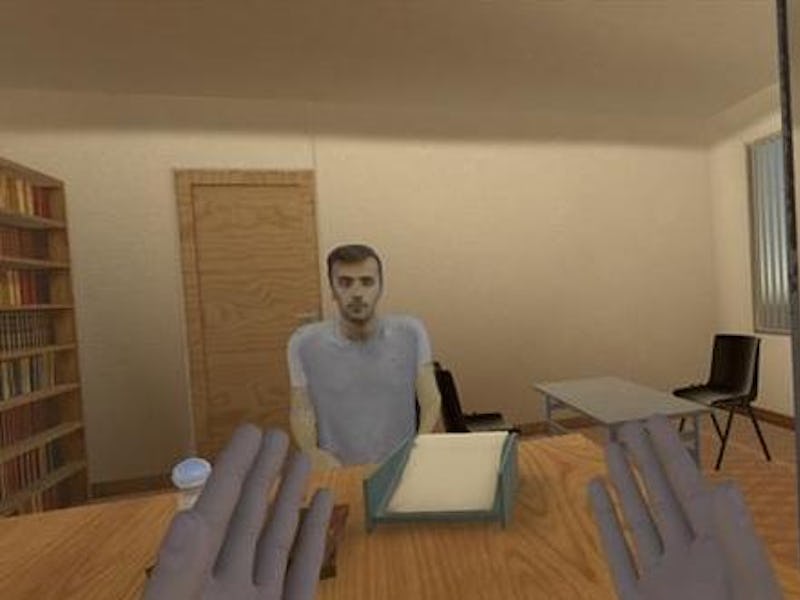Strange VR Study Shows Psychological Perks of "Body Swapping" With Freud
"It is the body swapping that matters."

Talking about personal problems is hard. Talking about personal problems to yourself after you’ve virtually body-swapped with Sigmund Freud might be slightly easier — he is the father of psychoanalysis, after all. This “body swapping” phenomenon isn’t the plot for a Westworld spin-off but the crux of a strange study released Monday in Scientific Reports.
"We are normally better at giving counseling to a friend than ourselves."
Virtual reality changes the way we interact with the world, but it also seems to change the way we interact with our internal lives — for instance, how we experience workout pain. Using a VR scenario that was tested on 58 participants, a team of scientists led by Mel Slater, Ph.D., a distinguished investigator at the University of Barcelona, showed that VR body-swapping may really help people work through problems.
“We are normally better at giving counseling to a friend than ourselves,” Slater tells Inverse. “What the body swapping enables is that you become ‘the friend’ — you see and hear yourself from the outside, as if you were someone else.”
Body swapping with Sigmund Freud in a VR experiment helped people facilitate "self-dialogue" and work through personal problems.
The method isn’t intended to replace traditional forms of psychological counseling, but body swapping may be one way to help people gain a crucial outsider perspective.
What Is Body-Swapping” Like?
The VR scenario goes something like this: Your personal VR avatar sits across the desk from a virtual Freud. While you’re inhabiting your own avatar, you spill your woes to him. Then, when it’s Freud’s turn to respond, the perspective flips.
"What the body swapping enables is that you become ‘the friend’.”
All of the sudden, you find yourself in Freud’s body looking at yourself across the table. Then, it’s up to you to advise yourself.
This scenario, as Slater explains, is intended to help promote self-dialogue, which is a way to talk through problems and arrive at a solution.
The “Solomon Paradox”
The core problem is that humans are better at dishing advice than they are at taking it. University of Waterloo psychologist Igor Grossman, Ph.D., termed this phenomenon the “Solomon Paradox” in a 2014 paper in Psychological Science.
The Solomon Paradox is based on the biblical King Solomon, who was acclaimed for his wisdom but fumbled when it came to his own problems. Solomon ultimately made a series of bad decisions that “contributed greatly to his kingdom’s demise,” Grossman writes.
Solomon’s legacy lives on today in all of us. In Grossman’s experiments, participants displayed “wiser” reasoning when they tried to solve other people’s problems compared to when they tried to fix to their own issues.
When Grossman proposed the Solomon Paradox, he also showed that “self-distancing” — attempting to separate yourself from a self-centered perspective — actually makes people better at giving themselves advice.
Using VR, Slater and his team supercharged that “self-distance,” allowing people to transcend their biological bodies and virtually inhabit Freud’s.
In the new study, body swapping really did seem to assuage the problems of the study’s 58 participants. Half of them body swapped with Freud and had a dialogue with themselves; the rest spoke to a Freud who had scripted responses. After one week, 86 percent of the body swappers reported that they felt differently about their problems, while only 48 percent of people in the control group did so.
The Added Benefits of Body Swapping
Slater and his team began working on the body swapping project in 2014. In 2015, they published a proof of concept paper in Scientific Reports showing that VR is more effective in facilitating self-dialogue when a person literally inhabits another form. That study showed that mood improved more when people spoke to themselves as Freud than when they inhabited a virtual body that looked like themselves.
At that point, they weren’t sure whether it was simply talking about their feelings that was making people feel better or whether inhabiting another form was key. This study cleared things up.
"We showed specifically that it is the body swapping that matters,"
“In the latest study we showed specifically that it is the body swapping that matters,” Slater says.
The key to body swapping is that you have a strong illusion of body ownership. When Freud moves, you move, and when he speaks, you speak. In that sense, VR truly allows you to inhabit someone else and see yourself from the outsider’s perspective.
That out-of-body experience seems like it may be pretty useful down the road — even if that new, virtual body happens to be that of a 20th-century psychiatrist who was pretty into phallic dream imagery.
Abstract:
When faced with a personal problem people typically give better advice to others than to themselves. A previous study showed how it is possible to enact internal dialogue in virtual reality (VR) through participants alternately occupying two different virtual bodies – one representing themselves and the other Sigmund Freud. They could maintain a self-conversation by explaining their problem to the virtual Freud and then from the embodied perspective of Freud see and hear the explanation by their virtual doppelganger, and then give some advice. Alternating between the two bodies they could maintain a self-dialogue, as if between two different people. Here we show that the process of alternating between their own and the Freud body is important for successful psychological outcomes. An experiment was carried out with 58 people, 29 in the body swapping Self-Conversation condition and 29 in a condition where they only spoke to a Scripted Freud character. The results showed that the Self-Conversation method results in a greater perception of change and help compared to the Scripted. We compare this method with the distancing paradigm where participants imagine resolving a problem from a first or third person perspective. We consider the method as a possible strategy for self-counselling.